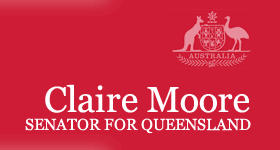Senator MOORE (Queensland) (17:21): I know that in this place we begin every morning with an acknowledgement of country-an initiative that we are proud of and that we will continue-but I feel that at the beginning of this contribution I would like to make a personal acknowledgement of the traditional owners of our land, particularly as we are talking about such an important element: closing the gap. Senator Lazarus, I am a huge fan of that carnival. I was unaware that its funding was not secure, and I think that we can share in working towards securing funding. We cannot lose that event and all that feeds out of it.
This morning we heard the Closing the Gap program being introduced again, with the presentation of the seventh annual report. The Close the Gap Campaign Steering Committee, which has been working since 2006 in this area, puts out its own report, which Senator Siewert tabled earlier. At the conclusion of their shadow report, which I think is essential reading in terms of looking at engagement with the Aboriginal and Torres Strait Islander community in our nation, they say that the report that they have prepared:
… affirms the need to stay the course with the Closing the Gap Strategy and to be patient for improvements sought to Aboriginal and Torres Strait Islander health and life expectancy-progress which many indicators suggest will be seen in time.
I endorse so much that is in this report and I know there is a need to stay the course, but I am not sure whether I share the concept of patience in trying to ensure that we get greater results against the initiatives that were clearly identified seven years ago-issues that were brought forward to this place and throughout the community; issues that need to be addressed to ensure that we can genuinely have an Australian community which is equal. This morning, in the Leader of the Opposition's speech in the other place, he said that a true community shows equality and that we must have that.
I am not sure whether patience, in this case, is such a virtue. I know that we need to have commitment. I know that the bringing down of this report is an opportunity for all of us to review what has occurred, to look back and, in particular, to pay credit to so many people who have worked so hard in this area for generations. It is an opportunity to acknowledge their contributions but also to take a serious and-I think-a critical strategic look at what has been achieved. The news is not good. Of course we need to celebrate where there have been some advances. We see advances in the area of halving the gap of life expectancy. There has been a very small increase there. We need to acknowledge it; we need to celebrate it. But we also need to understand that, continuing at the same rate, we will not meet the goal, which was set seven years ago, to halve that gap. But I think that we have to acknowledge that something has been done.
We also looked very clearly at halving the gap for Indigenous Australians aged 20 to 24 in year 12 attainment or equivalent. That is an area where the education programs-over years, and working effectively with states and territories-have led to a more positive result. But on so many of the other areas we are not on track. So that must lead to the consideration of what we should do and what we could do differently. In that sense, the government has support to look at ways to change the way that we operate, but that support needs to be endorsed by the wider community and, in particular, by the Aboriginal and Torres Strait Islander community. We cannot impose policy or implement policy which is not accepted by those whom it is intended to serve.
In my short contribution today I want to talk about two things that I think need to be added to the considerations in looking at closing the gap. One of these has been mentioned by many speakers, and that is around the call to include a justice target in our Closing the Gap strategy. This has been talked about for many, many years. At the end of last year, my friend Mick Gooda, who is the Aboriginal and Torres Strait Islander Social Justice Commissioner, made a formal call to the government to look at including a special justice goal in the Closing the Gap strategy, because of the horrors of the inequitable involvement of people who are Aboriginal or Torres Strait Islander in our corrections system.
The statistics are extraordinarily confronting. We have heard them in previous contributions. The Productivity Commission released figures in November last year indicating a 57 per cent rise in incarceration rates amongst Indigenous men, women and children over the previous 15 years. That statistic alone demands action from governments across this country. There is no way that a statistic showing a 57 per cent increase in jailing rates in the juvenile justice system and in the open justice system should be considered to be acceptable in our community-and it is not. No-one accepts that particular finding.
The important thing is that we have the opportunity to make change. We know that there are projects that have been put in place all over the country-relatively small projects which have identified a need at a local level and looked at what can actually be implemented cooperatively to ensure that there are other options than incarceration and that there is identification of what causes Aboriginal and Torres Strait Islander people to end up through the court system and then-at such a significantly higher rate than the mainstream community in Australia-end up with jail sentences, which tend to then lead to a sequence of being in and out of prison with no chance to build better lives. There are all kinds of reasons that have been clearly identified-education opportunities, health opportunities, employment opportunities-all of which are in the Close the Gap strategy. So actually implementing a particular justice goal in our closing the gap process is not such a big stretch, because the need and the engagement are already in place across the country.
Mr Gooda made a quite straightforward recommendation that we revise the current targets in closing the gap to include holistic justice targets aimed at promoting safer communities. We also suggest that the Australian government consult and work with the National Justice Coalition, which has been so active in this area and shows examples of where local community work has led to a change. We also suggest that the Australian government take a leadership role on justice reinvestment and work with the states, territories, and Aboriginal and Torres Strait Islander communities to identify further trial sites along the way that has been led by the National Justice Coalition.
I think we have the opportunity to make the Close the gap report a dynamic document that responds to the needs of the community and is not set on something that was determined seven years ago. I think there is an opportunity today, when we are looking at the Close the Gap program, to say that there should be a justice strategy implemented that can be agreed on across whatever will take the place of COAG.
The other thing I want to throw in is the issue of mental health. This particular report actually calls for the development of a national strategy specifically looking at mental health in Aboriginal and islander communities. Again, confronting and horrific statistics show that the impact of mental illness in Aboriginal and Torres Strait Islander communities has a stronger impact in terms of non-diagnosis, effective treatment and also the ongoing issues around substance abuse and violence, which all coalesce to ensure that the community is not receiving equitable services and that we cannot say that we are closing any gap around making our society better and more equal.
I commend the committee that actually put together the progress and priority report. I again say I am not sure whether I can share their call for patience to ensure that we can make more progress, but I can say that I commit with them to staying the course so that, when we have the eighth report next year, hopefully we will see more progress.




